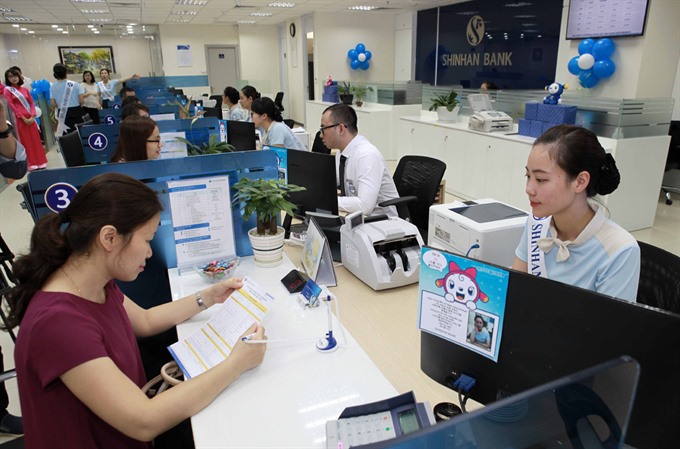Bad debt measures go into effect
 |
| Customers and employees at Shinhan Bank’s office on Lý Thái Tổ Street, Hà Nội - VNA/VNS Photo Trần Việt |
Resolution 42 allows lenders to process collateral as they see fit if debtors fail to cooperate with them on resolving their bad debts.
Article 10 states that debtors’ collateral to banks is not limited to residential construction projects, as there is no clear legal restriction on other types of real estate, such as hotels, resorts, even factories and power plants, to be used in place of pledged assets.
As such, this allows for more flexible use of collateral, preventing debtors from defaulting for lack of valuable assets.
Resolution Article 7 also acknowledges credit institutions’ right to commandeer pledged assets from debtors, according to their debt contract, unless the asset in question is being held by litigation courts as evidence of a criminal offence on the debtors’ behalf.
This is considered an improvement on the 2015 Civil Code, which does not stipulate recourse for pledged assets.
Article 8 of the Resolution allows more transparent and simplified legal procedures in dealing with disputes over nonperforming loans.
Additionally, Resolution 42 now allows for financial institutions capable of purchasing and selling bad debts to do so, instead of restricting these activities to Government entities. Bad debts can now be sold below their book values, meaning they are no longer toxic assets that have lost nearly all their value for commercial banks.
Thus, banks can now sell off bad debt collateral at a lower value than they initially documented in their accounting tables, without fear of the sale being considered a loss, according to Chairman Nguyễn Tiến Đông of the Vietnam Asset Management Company (VAMC) who spoke at a conference last week on implementation of Resolution 42.
Overall, this can lead to bad debts being traded more frequently on the merger and acquisition market (M&A) in at least the next five years, according to a representative of the State Bank of Vietnam (SBV).
Speaking at last week’s 2017 Vietnam M&A Forum, Nguyễn Hữu Quang, deputy head of the NA’s Financial and Budgetary Committee, said that after three and a-half years, some 42,000 nonperforming loans held by 50 credit institutions had been purchased through VAMC, retrieving up to VNĐ53.2 trillion (US$2.3 billion) in value.
Since the beginning of 2013 till the second quarter of 2017, up to VNĐ616.7 trillion ($27.4 billion) worth of national uncollectible loans have been dealt with, according to SBV data. Out of this amount, up to 56.7 per cent was solved by lending credit institutions, while 43.3 per cent was sold to other financial entities.
Quang said that initially, the Government was aiming for commercial banks’ reconstruction, which gradually led to the need for a separate resolution on bad debts instead of simply tweaking the existing laws on credit institutions.
The SBV has voiced concern over the need for commercial banks and other financial institutions to have more elbow room not only in managing nonperforming loans, but also in issuing common stocks on the market, which they claim Resolution 42 has yet to address.
What the stars mean:
★ Poor ★ ★ Promising ★★★ Good ★★★★ Very good ★★★★★ Exceptional
Latest News
More News
- Securing capital and efficiency for Vietnam’s 2026-2030 growth ambitions (December 17, 2025 | 10:00)
- Energy sector in need of blended finance mechanisms (December 17, 2025 | 09:00)
- Vietnam still has room to mobilise capital for sustainable growth (December 17, 2025 | 08:57)
- Long-term capital seen as key hurdle to green growth (December 16, 2025 | 08:00)
- Gold prices swing amid tax debate and import uncertainty (December 15, 2025 | 18:04)
- Agribank frames bank credit as catalyst for green growth (December 15, 2025 | 17:59)
- Vietnam’s green transition demands collective financial action (December 15, 2025 | 12:00)
- VIR workshop highlights capital and policy for sustainable development (December 15, 2025 | 11:00)
- Promoting digital assets initiative in Vietnam (December 13, 2025 | 09:30)
- Experts flag gaps as national financial strategy under review (December 12, 2025 | 15:13)


















 Mobile Version
Mobile Version